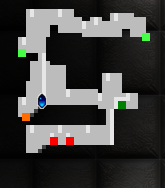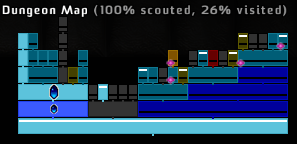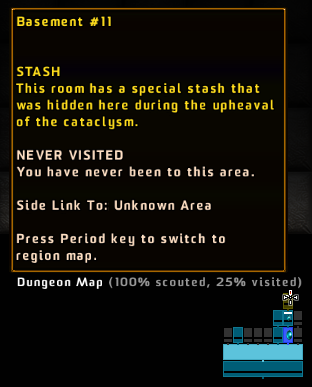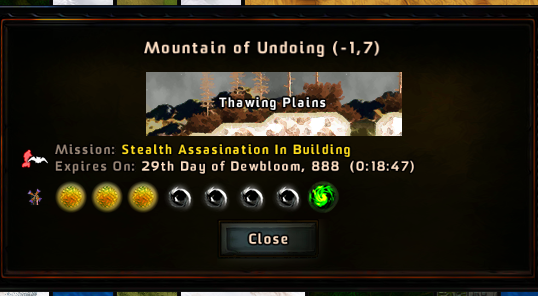Difference between revisions of "Valley 1:What are all these maps for?"
| Line 1: | Line 1: | ||
A Valley Without Wind offers a vast set of tools and maps to help you explore Environ in an efficient manner. This guide will help you to learn how to use these tools. | A Valley Without Wind offers a vast set of tools and maps to help you explore Environ in an efficient manner. This guide will help you to learn how to use these tools. | ||
| − | ==Chunk Map (aka, Minimap) == | + | == The Hierarchy Of The World == |
| + | |||
| + | It's helpful to understand how the world is organized, and what terminology is used. | ||
| + | |||
| + | === The World Itself === | ||
| + | Each world of Environ is unique. You can call your world whatever you want in order to be able to find it when you have multiple worlds, but each one you create represents an alternate reality of a single world called "Environ." In AVWW, the world of Environ is infinite (or at least so unbounded that nobody could reach the end of it within a human lifespan). | ||
| + | |||
| + | === Continents === | ||
| + | The world is divided into continents. Each continent is being oppressed by an overlord and that overlord's lieutenants. Saving one continent by killing its overlord will reveal the next continent on the world map. | ||
| + | |||
| + | === Regions === | ||
| + | Each tile on the world map represents a region. With a very few exceptions (deep sea tiles and ports), any time you press the Confirm key on a region tile, you will enter a side view action-adventure segment that lets you explore around that region as much as you want. A single region can be infinitely large thanks to the way its cave systems are set up. Also it's worth noting that the surface area of the region that you can directly explore is really only a part of the region; when you do missions in that region, you'll find yourself in parts of the region that are only accessible for the duration of that mission itself. | ||
| + | |||
| + | === Dungeons === | ||
| + | There are three kind of dungeons: surface/exterior, interior/building, and underground/cavern. It bothers some folks that we call the surface of a region a "dungeon," and certainly in the classical sense of the word that's a misnomer. But in the world of video games it's very fitting, especially considering the nature of our surface dungeons. | ||
| + | |||
| + | There is typically only one surface dungeon in a region, although when you enter missions you may find yourself having access to other, smaller surface dungeons temporarily. Each building you encounter, whether on the surface or underground, has a single interior dungeon contained within it. And each cave system that you enter is one underground dungeon; but most underground dungeons also contain a link down to a deeper underground dungeon (with tougher monsters, by the by). | ||
| + | |||
| + | === Chunks/Rooms/Nodes === | ||
| + | The actual area you are in when you are wandering around in side view is known as a chunk, because it represents either a chunk of an exterior environment, a chunk of an underground cave, or a room in a building. In buildings we tend to just call them rooms, but sometimes when referring to the dungeon map we refer to them as nodes in the map. Sorry about any confusion there. | ||
| + | |||
| + | == Chunk Map (aka, Minimap) == | ||
Once you are in the room, cave, etc. that you want to be in, you can use the minimap in the top right to get around. | Once you are in the room, cave, etc. that you want to be in, you can use the minimap in the top right to get around. | ||
| Line 16: | Line 37: | ||
The grey shaded portion towards the bottom right part of the map represents an unexplored part of the room. The shading will go away as you approach that part of the room. | The grey shaded portion towards the bottom right part of the map represents an unexplored part of the room. The shading will go away as you approach that part of the room. | ||
| − | |||
| − | |||
| − | |||
| − | |||
==Dungeon Map == | ==Dungeon Map == | ||
Revision as of 15:50, 13 March 2012
A Valley Without Wind offers a vast set of tools and maps to help you explore Environ in an efficient manner. This guide will help you to learn how to use these tools.
Contents
The Hierarchy Of The World
It's helpful to understand how the world is organized, and what terminology is used.
The World Itself
Each world of Environ is unique. You can call your world whatever you want in order to be able to find it when you have multiple worlds, but each one you create represents an alternate reality of a single world called "Environ." In AVWW, the world of Environ is infinite (or at least so unbounded that nobody could reach the end of it within a human lifespan).
Continents
The world is divided into continents. Each continent is being oppressed by an overlord and that overlord's lieutenants. Saving one continent by killing its overlord will reveal the next continent on the world map.
Regions
Each tile on the world map represents a region. With a very few exceptions (deep sea tiles and ports), any time you press the Confirm key on a region tile, you will enter a side view action-adventure segment that lets you explore around that region as much as you want. A single region can be infinitely large thanks to the way its cave systems are set up. Also it's worth noting that the surface area of the region that you can directly explore is really only a part of the region; when you do missions in that region, you'll find yourself in parts of the region that are only accessible for the duration of that mission itself.
Dungeons
There are three kind of dungeons: surface/exterior, interior/building, and underground/cavern. It bothers some folks that we call the surface of a region a "dungeon," and certainly in the classical sense of the word that's a misnomer. But in the world of video games it's very fitting, especially considering the nature of our surface dungeons.
There is typically only one surface dungeon in a region, although when you enter missions you may find yourself having access to other, smaller surface dungeons temporarily. Each building you encounter, whether on the surface or underground, has a single interior dungeon contained within it. And each cave system that you enter is one underground dungeon; but most underground dungeons also contain a link down to a deeper underground dungeon (with tougher monsters, by the by).
Chunks/Rooms/Nodes
The actual area you are in when you are wandering around in side view is known as a chunk, because it represents either a chunk of an exterior environment, a chunk of an underground cave, or a room in a building. In buildings we tend to just call them rooms, but sometimes when referring to the dungeon map we refer to them as nodes in the map. Sorry about any confusion there.
Chunk Map (aka, Minimap)
Once you are in the room, cave, etc. that you want to be in, you can use the minimap in the top right to get around.
The dot colors mean different things:
- Dark Blue – The player's position.
- Dark Green – Doors that the player has already traveled through.
- Red – Doors that the player has not gone through.
- Orange – Loot items such as platforms and scrolls.
- Light Green – Other types of loot such as EXP Containers (or Vitality Stones).
The grey shaded portion towards the bottom right part of the map represents an unexplored part of the room. The shading will go away as you approach that part of the room.
Dungeon Map
The “dungeon map” can be found in the bottom right corner of the screen (if you don't see it, you can press comma (,) to bring it up) and looks like this:
This is used to represent the relationship between rooms in a building. Each rectangle is a room. A rectangle directly above another means that there is a connection between the two rooms (usually a door). The diamond outline shows you what room you are currently in, a smaller, blinking diamond will appear on the map when you are standing in front of a door showing you the room that that door leads to. A rectangle being above another one does not necessarily indicate that it is on a higher floor, only that it is deeper into the building, the bottom-most room will most likely have a door to/from the outside.
Each color has a different meaning:
- Light Blue – Normal room
- Dark Blue – Staircase, either up or down
- Yellow – Stash Room, these hold a variety of items from warp/health potions to rare scrolls.
If you forget what the colors mean, if you run across a color not listed here, or if you want more information about a specific room, you can hover your mouse cursor over the room, the tooltip will look like this:
The black lines towards the bottom of some rooms means that you have not yet been to those rooms. Unvisited rooms are also darker on the map. Once you enter each room, the line disappears, and the room gets brighter. The white line towards the top of some rectangle represents an alternate connection between the rooms, such as a vent.
Region Map
You can get a similar map of the entire region by pressing the period (.) key.
The blue squares represent buildings that you have been in, the gold at the bottom represents caves. Using this map, you can warp directly into any room you have already been in from any point in the region you are currently in (even another building).
World Map
This is the overland map, it will not only show you the types of regions you can enter in your world, but it will let you know about the important features in each region.
For example, clicking on one of the mission squares on the above map might bring up a box similar to the one below, telling you all the information you need to know on the mission in that region.





